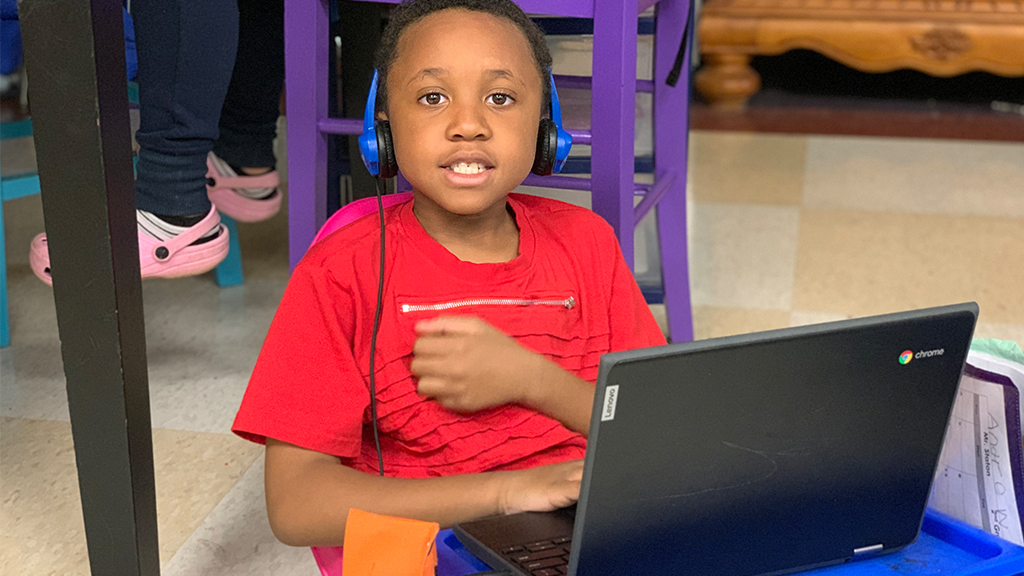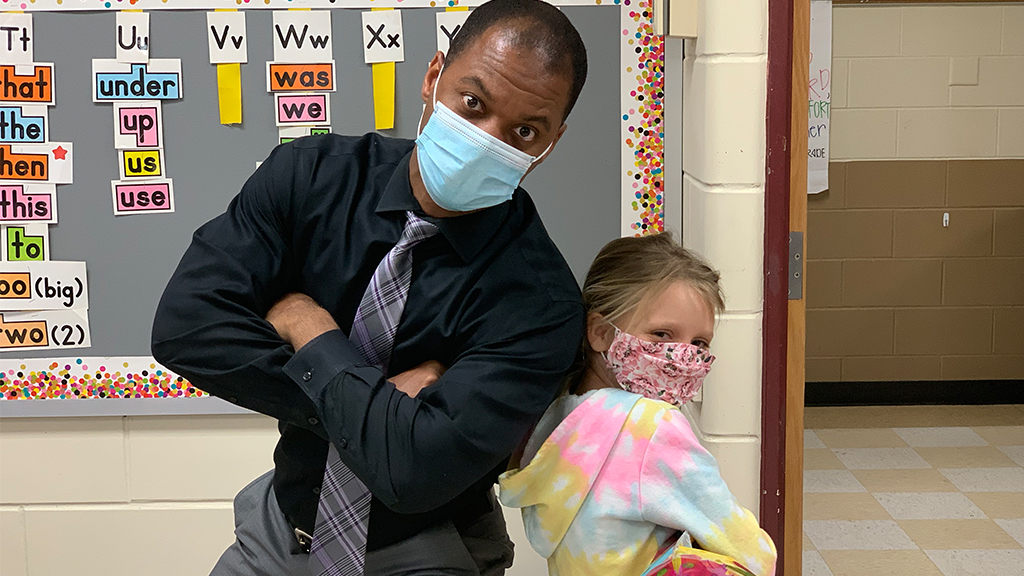
Photo credit: OFOTO/STOCK.ADOBE.COM
A year ago, the coronavirus pandemic wedged Marlon Styles between a particularly heavy rock and a very hard place: He had to send his students home to learn, with little warning. It was clearly best for their health and safety. But he also knew this: To do so was to sentence kids, in many cases, to spending school days in homes that weren’t set up for even rudimentary distance learning.
In those first weeks, the dilemma “was really accelerating, and intensified by so many people advocating closing, us included,” says Styles, superintendent of the Middletown City School District in southwestern Ohio. His small urban district—about 6,200 students, 100 percent of whom are eligible to receive free and reduced-price lunch—sits midway between Cincinnati and Dayton. The median household income? Just $39,000.
As in many districts with a high proportion of low-income students, unreliable or nonexistent internet access loomed as yet another risk factor. It even has a name: the homework gap.
But what Styles and other school leaders have done in the year since could serve as a model for schools as they contemplate an era in which distance learning endures after the pandemic fades.
Homework with a side of fries
While pundits have invoked the phrase “homework gap” thousands of times since last spring, it actually describes a very specific phenomenon. Jessica Rosenworcel, an attorney who has spent years working on connectivity issues on Capitol Hill, coined it after hearing “the same stories over and over again: Kids sitting in the school parking lot with school laptops they had borrowed late into the evening, trying to peck away at homework because that was the only place they could actually get online. Or kids sitting in fast food restaurants and doing their homework with a side of fries.”
Rosenworcel in October told MIT Technology Review that she’d been thinking about the gap between the high percentage of teachers who assign homework requiring internet access, and the not-as-high percentage of kids with reliable home broadband.
About 70 percent of teachers say they expect students to access the internet at home. But nearly one in five teens has said that he or she is “often or sometimes” unable to complete homework assignments because there’s no reliable home access to a computer or internet, according to a 2018 Pew Research Center survey. Pew found that Black teens, as well as those in lower-income households, were more likely to say this is a problem.
“I started calling where those numbers overlap the ‘homework gap’ because I felt that this portion of the digital divide really needed a phrase or a term to describe it,” Rosenworcel said.
A 2015 Pew study found that about 35 percent of households with an annual income below $30,000 didn’t have high-speed internet, nearly six times the average of upper-income households.
In all, a recent analysis of 2018 U.S. Census Bureau data by the Alliance for Excellent Education’s Future Ready Schools project found an estimated 16.9 million children don’t have high-speed internet at home. Rates are especially low across the south: In Texas, 29 percent of households don’t have high-speed internet. In Mississippi, it’s 42 percent.
Mary Ann Wolf, president and executive director of the Public School Forum of North Carolina, says fewer than 40 percent of households across the state have access to an affordable, wired broadband internet connection.
“The affordability piece is something very significant that we see,” says Wolf, who previously led the State Educational Technology Directors Association (SETDA). “And I know North Carolina is not alone in this.”
Like others, Wolf has pushed to get policymakers to think about internet access as a utility, not a luxury. District leaders have made a point of telling her that while internet access is important for learning, “it’s also really important for access to school counselors, to telehealth, to other opportunities. And it’s just something that we never really thought about before, when we could at least try and provide that in the school setting.”

Photo credit: Middletown City School District
Once the pandemic hit, of course, the stakes tied to the homework gap became much higher, leaving students with few ways to access not just homework help, but everything school has to offer, including daily interactions with teachers and peers.
Bob Wise, a former West Virginia governor and congressman who has spent decades focusing on education and access, says reliable internet access is now especially required for college success: for filling out college applications and financial aid forms, accessing counseling services, and more. And of course, the recent pandemic recession has affected parents too, millions of whom find themselves out of work and searching for employment.
So in addition to more than 50 million K-12 students who need the internet for studying, Wise says, “we’ve got something like 20 to 25 million parents, presumably, who are unemployed or underemployed and will need job training. It’s the largest number since World War II. And a lot of that’s going to have to be digital.”
NSBA Executive Director and CEO Anna Maria Chávez agrees. “I just don’t see this as an education issue,” she says. “I see this as a human issue.”
The pandemic has revealed not only deep, systemic inequality. It also has revealed the ways in which that inequality plays out, limiting opportunity at the most basic level.
“We can’t go back,” Chávez says. “There’s no way we can go back to what used to be considered the normal way of educating in the United States. We now have an opportunity to actually leapfrog over the former state and start rebuilding this infrastructure to meet the needs of kids today in the 21st century.”
The real problem
In Ohio, Styles already was tackling the homework gap before the pandemic hit, aware that many students were unconnected at home.
He readily admits that, in a previous era, he’d have put more energy into identifying the problem than actually solving it. “Most people would ask, ‘How many of your kids don’t have internet access?’” he says. “And most of the time—and I’ll say I’m guilty of this—I was answering that question with a percentage.”
A helpful bit of information, but that wasn’t helping anyone. “If we truly are in the business of serving kids, I wanted to be able to know which students we were not serving. So we transitioned our thought very quickly.”
Styles partnered with internet service providers to figure out exactly which households didn’t have reliable broadband.
Working with three local service providers, the district spent more than two months identifying every home across the city that fell into this category. Then it cross-referenced each address with a student database to find exactly which students fell within the “homework gap.”
“Once we figured out what the real problem was,” Styles says, “how big or how significant the gap was that our students were facing, we went all in. And we committed to closing it.”
Across the city, from first grade on up, Styles sent home wireless hot spots to every family that needed one. For families with multiple students, he sent home two. He readily admits that this fix, as radical as it may seem, wasn’t designed to fully solve the district’s homework gap. But it’s a strong start. “We have our kids connected. It’s a short-term solution.”
It’s also, he admits, a rather expensive one: about $304,000 a year for a two-year agreement. “We know that’s a lot of money, but it’s an important resource that kids need to remain logged in and continue that education at home.”
Thomas C. Murray, director of innovation at Future Ready Schools, says another problem is that families often bump up against the limits of data plans—especially in an era of extended classroom Zoom sessions.
|
NSBA's homework gap advocacy The COVID-19 pandemic has highlighted a long-documented and persistent inequity affecting students who lack adequate broadband access. The homework gap also impacts some of the most vulnerable students such as those with disabilities. As the learning environment for students has shifted from traditional classrooms in school buildings made of bricks and mortar to virtual classrooms, the necessity for each student to have high-quality access to the internet is imperative. With the current crisis dramatically shifting our children’s education to remote and online learning, it has never been more important to address this inequity. NSBA supports efforts to improve necessary high-speed broadband required for 21st century learning both when students are in school and when they are home. School board members across the nation are joining NSBA in urging the Federal Communications Commission and Congress to focus on ways to improve the overall connectivity and digital infrastructure for all students and to abandon efforts to make connectivity more difficult. Closing the homework gap is a pressing national need that must be addressed so all students can receive an excellent 21st century education. “If anybody can galvanize communities, we can,” says NSBA Executive Director and CEO Anna Maria Chávez, “but we’re going to need the help of our peers and the federal government and the philanthropic community so that it doesn’t become partisan. It becomes about the kids.” |
“You give a kid a hot spot, you assume you’re good for the month—and they’re streaming video all day long,” he says. “That data gets eaten up really, really quickly.”
Murray has consulted with school districts that hand out these devices and find that families consume a month’s worth of data in a week-and-a-half. Also, he says, solutions like this may work better in heavily populated areas than in rural ones: “You can hand a kid a hot spot, but if it’s got no cell signal, it’s a paperweight.”
Yet leveraging broadband connectivity for these families—what he and others call “the last-mile problem”—is a tough sell for school districts hoping to prevail upon cable providers to do the right thing. “No cable provider wants to go lay fiber out to three homes six miles away,” he says. “Nobody’s going to do that.”
Stimulus money coming
In its second stimulus package, approved in December, Congress handed the FCC’s E-Rate program a $7 billion infusion for school and library internet. But the $3 billion appropriated for low-income families to help pay for data plans and devices like hotspots may fall short. Recent estimates have suggested that this group may be as large as 33 million.
Ensuring adequate broadband in every community “will have a much greater return on investment and a faster one than anything else we can do at this stage,” Wise says. As the pandemic has shown, both students and parents will likely be spending a lot more time studying and working from home. “If you don’t have broadband, then you’re not going to be in the mix,” he says.

Photo credit: Middletown City School District
Just as, in a previous era, paved roads and highways brought economic development to isolated areas, broadband now does the same—actually, Wise says, it probably does more. While a rural community in 2021 can’t easily persuade General Motors to build a new transmission plant, it can persuade educated adults with high-paying tech jobs to relocate.
Rosenworcel, who is now acting chairwoman of the FCC, has predicted that it’ll be hard work to make sure all families are connected. “But we’ve done it before,” she told an interviewer recently. “We did it with electricity following the Rural Electrification Act. We did it with basic telephony. We can do it again with broadband.”
Back to normal?
After months of remote learning, Styles began welcoming students and staff back to Middletown’s buildings in January with hybrid learning. In mid-March, with most of his staff vaccinated, students began attending in-person full time. “We’re in a position now where we’re celebrating kids in school five days a week,” he says. “It’s very exciting.”
But even if, like Middletown, most K-12 schools are fully back to in-person learning in the fall, teachers likely won’t abandon online learning. Many have started to use tools and strategies that will require more, not less, internet access, says North Carolina’s Wolf.
As he thinks about the past year, Styles notes that “the one celebration” that has come out of the pandemic is this: a more widespread awareness of systemic inequities in K-12 education. If nothing else, he says, the pandemic has made one thing clear: “All kids matter. All kids deserve to be connected. All kids deserve to have access to the resources and opportunities to learn.”
Greg Toppo (gregtoppo1@gmail.com) is a journalist and author of two books on education.

Share this content